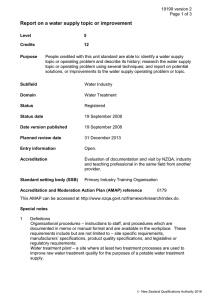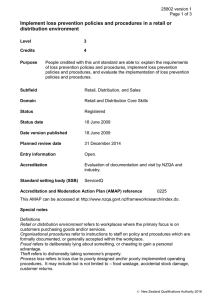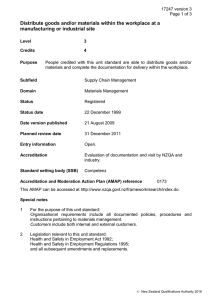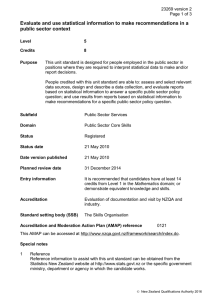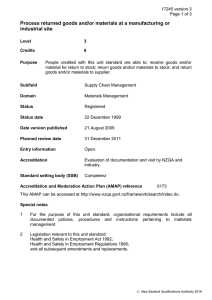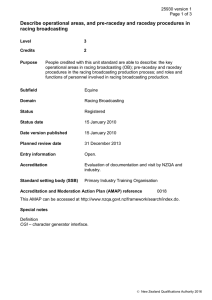Describe health and safety guidelines and risk control procedures while
advertisement
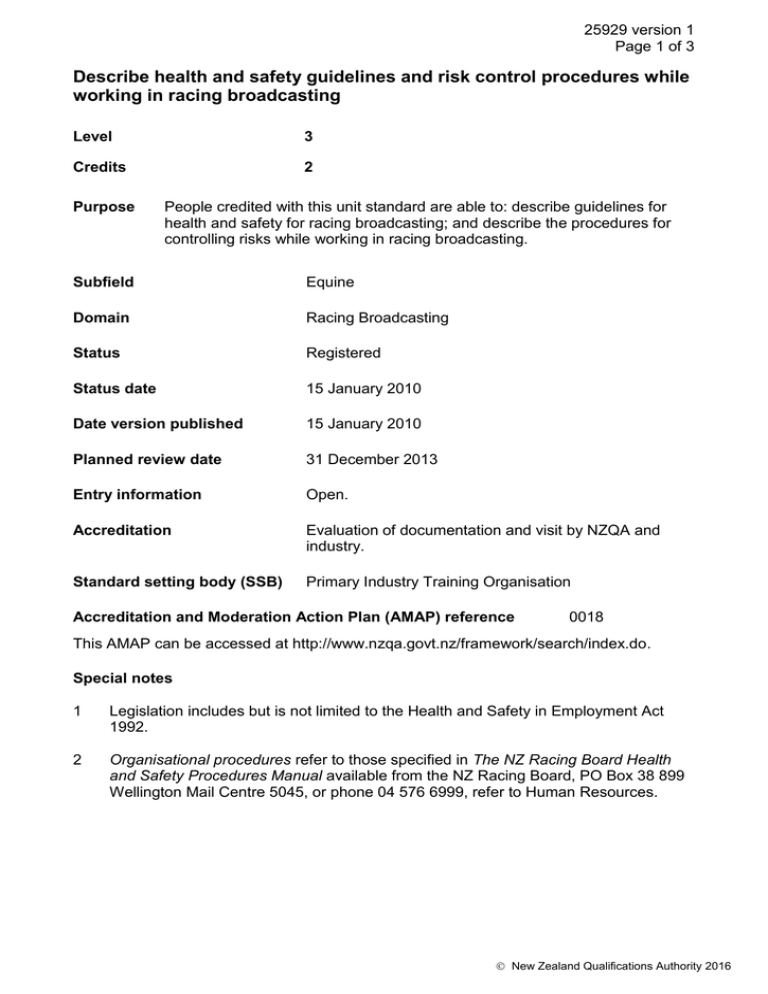
25929 version 1 Page 1 of 3 Describe health and safety guidelines and risk control procedures while working in racing broadcasting Level 3 Credits 2 Purpose People credited with this unit standard are able to: describe guidelines for health and safety for racing broadcasting; and describe the procedures for controlling risks while working in racing broadcasting. Subfield Equine Domain Racing Broadcasting Status Registered Status date 15 January 2010 Date version published 15 January 2010 Planned review date 31 December 2013 Entry information Open. Accreditation Evaluation of documentation and visit by NZQA and industry. Standard setting body (SSB) Primary Industry Training Organisation Accreditation and Moderation Action Plan (AMAP) reference 0018 This AMAP can be accessed at http://www.nzqa.govt.nz/framework/search/index.do. Special notes 1 Legislation includes but is not limited to the Health and Safety in Employment Act 1992. 2 Organisational procedures refer to those specified in The NZ Racing Board Health and Safety Procedures Manual available from the NZ Racing Board, PO Box 38 899 Wellington Mail Centre 5045, or phone 04 576 6999, refer to Human Resources. New Zealand Qualifications Authority 2016 25929 version 1 Page 2 of 3 Elements and performance criteria Element 1 Describe guidelines for health and safety for racing broadcasting. Performance criteria 1.1 Responsibilities of self and the race club venue are described in accordance with health and safety legislation. 1.2 Methods of communicating known risks and hazards are described in accordance with organisational procedures. Range includes but is not limited to – meetings, briefing, call sheets, instructions, safety notices, health and safety forms. Element 2 Describe the procedures for controlling risks while working in racing broadcasting. Performance criteria 2.1 Uncontrollable hazards and reporting procedures are described according to the organisational site safety plan and procedures. 2.2 Situations where the right to refuse to work may be exercised when necessary to ensure personal safety are described in accordance with organisational procedures. 2.3 Actions to prevent injury and damage in an unsafe situation are described in accordance with organisational procedures. Please note Providers must be accredited by NZQA, or an inter-institutional body with delegated authority for quality assurance, before they can report credits from assessment against unit standards or deliver courses of study leading to that assessment. Industry Training Organisations must be accredited by NZQA before they can register credits from assessment against unit standards. Accredited providers and Industry Training Organisations assessing against unit standards must engage with the moderation system that applies to those standards. Accreditation requirements and an outline of the moderation system that applies to this standard are outlined in the Accreditation and Moderation Action Plan (AMAP). The AMAP also includes useful information about special requirements for organisations wishing to develop education and training programmes, such as minimum qualifications for tutors and assessors, and special resource requirements. New Zealand Qualifications Authority 2016 25929 version 1 Page 3 of 3 Comments on this unit standard Please contact the Primary Industry Training Organisation standards@primaryito.ac.nz if you wish to suggest changes to the content of this unit standard. New Zealand Qualifications Authority 2016


